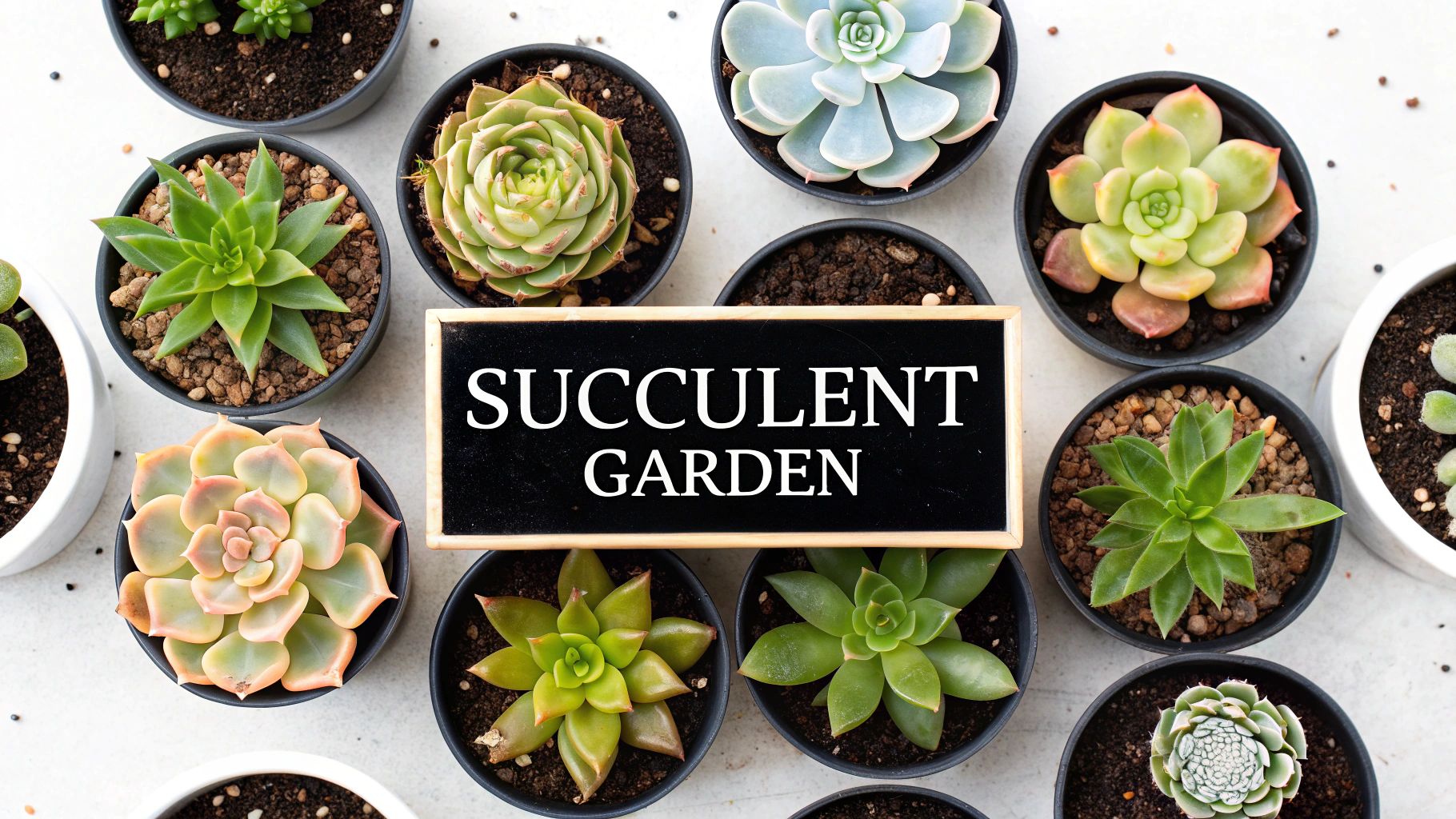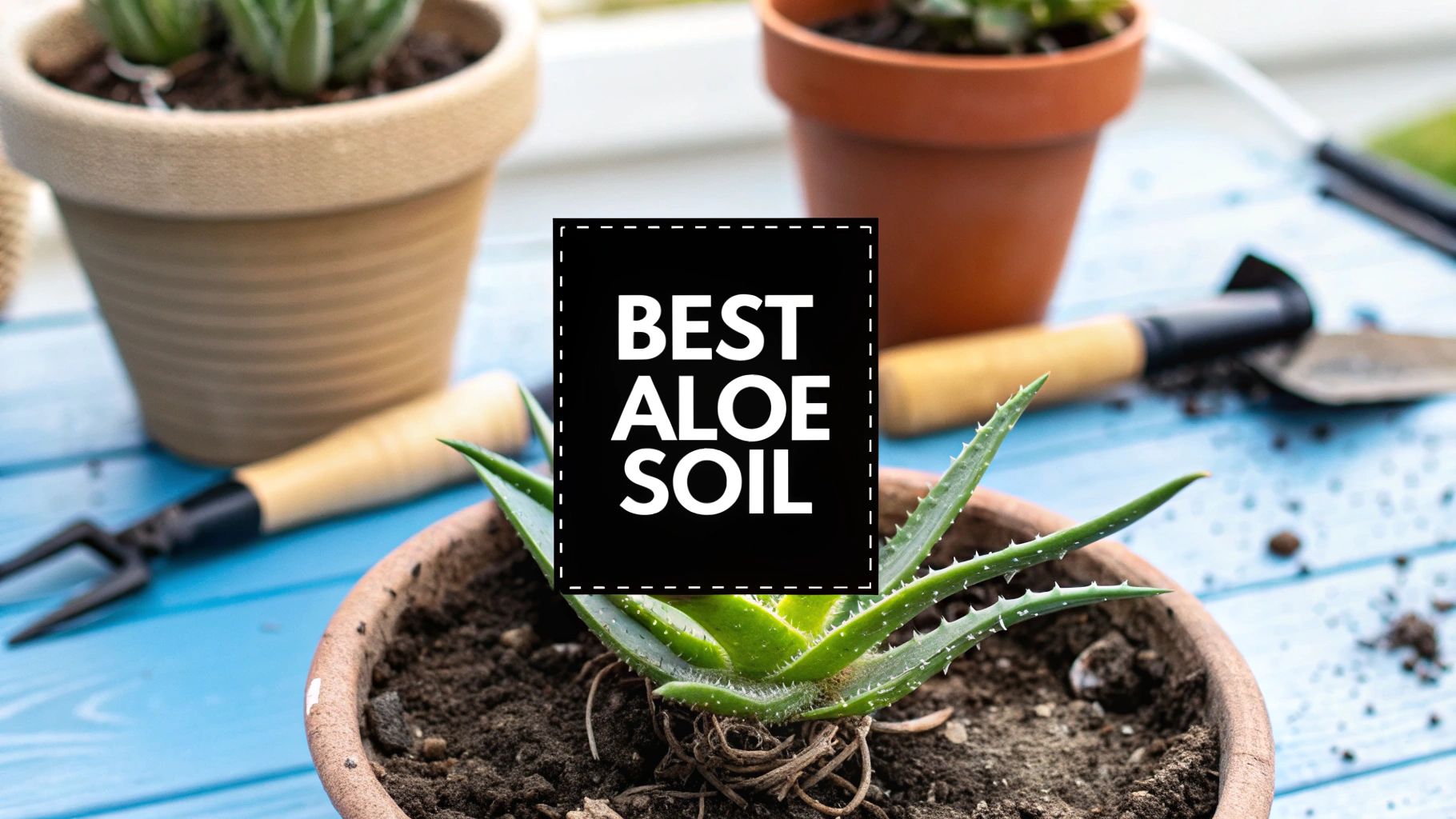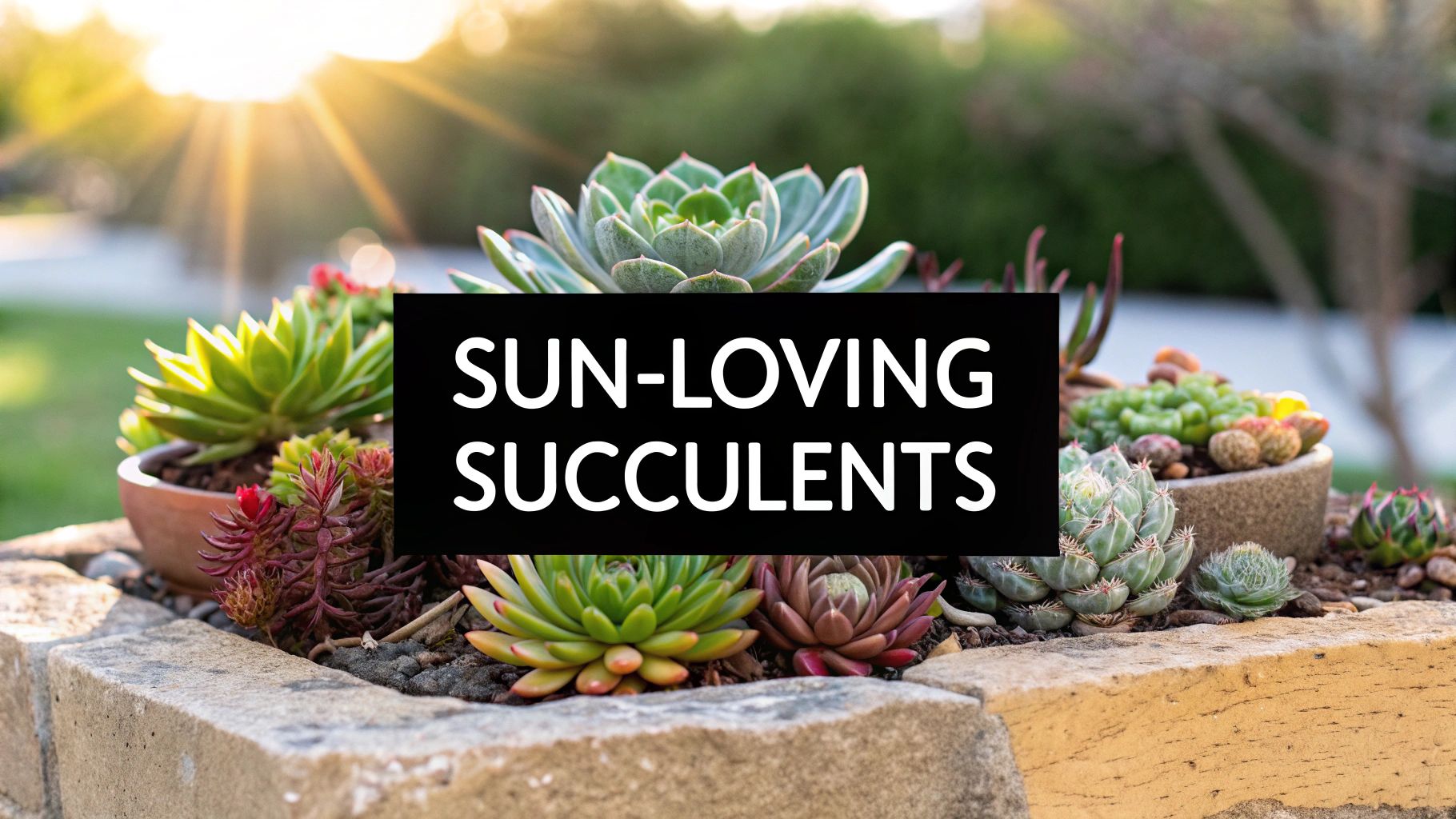Succulents offer more than just low-maintenance beauty; they are the architectural building blocks for stunning, water-wise landscapes and intricate container arrangements. Moving far beyond simply placing a plant in a pot, this guide delves into a curated collection of nine distinct succulent garden design ideas. Each concept presents a unique aesthetic and a practical blueprint for transforming your space, whether you have a sprawling yard or a compact urban balcony. We will explore everything from the rugged, naturalistic appeal of a desert rock garden to the artistic precision of a vertical succulent wall.
This is not a list of vague suggestions. Instead, you'll find actionable strategies and specific plant combination tips to bring these visions to life. Prepare to discover the perfect design that not only complements your home’s style but also showcases the incredible diversity of these resilient plants. We will provide the foundational knowledge you need to create a unique and thriving succulent sanctuary, helping you conceptualize and execute a design that truly reflects your personal taste. Let's dig into the specific layouts, styling advice, and practical considerations that will elevate your garden from a simple planting to a deliberate, captivating design.
1. Desert Rock Garden
A Desert Rock Garden is a sophisticated xeriscape design that artfully mimics the rugged beauty of an arid landscape. This approach goes beyond simply planting succulents; it involves the strategic placement of natural stones, boulders, and gravel to create a cohesive, low-water ecosystem. The goal is to design a scene that looks sculpted by nature, where hardy succulents like agaves, yuccas, and cacti emerge organically from rocky outcrops and beds of decomposed granite. This style is one of the most sustainable and impactful succulent garden design ideas for dry climates.

This design is ideal for homeowners seeking a dramatic, low-maintenance landscape that conserves water and thrives in full sun. It’s a style popularized by landscape architects like Steve Martino, who masterfully blend architecture with the natural desert environment. The result is a garden that offers year-round visual interest through diverse textures, forms, and subtle color shifts.
Implementation Tips
To successfully create a desert rock garden, focus on authenticity and thoughtful plant placement. A well-executed design relies on the interplay between hardscape and softscape elements.
- Source Local Stone: Choose rocks and boulders native to your region. This not only creates a more authentic look but also ensures the materials are suited to your local climate.
- Create Microclimates: Use large boulders to shield more tender succulents from the intense afternoon sun or to retain heat for plants that require it. This allows for a greater variety of species.
- Group by Water Needs: Arrange plants with similar watering requirements together. This "hydrozoning" prevents over or underwatering and simplifies maintenance. For a deeper dive into species selection, you can explore a wide variety of Arizona succulent plants that are perfect for this style.
- Use Natural Pathways: Opt for decomposed granite or fine gravel for pathways. These materials blend seamlessly into the design, enhance drainage, and suppress weeds.
2. Vertical Succulent Wall
A Vertical Succulent Wall is a contemporary and space-efficient design that transforms a bare wall or fence into a living art installation. This method involves growing succulents in specially designed vertical planters, frames, or modular panels, creating a stunning tapestry of color and texture. The concept is to maximize growing area in small spaces like balconies, patios, or urban gardens, turning a vertical surface into a lush focal point. This is one of the most innovative succulent garden design ideas for modern landscapes.

This design is perfect for gardeners with limited horizontal space or anyone looking to add a dramatic "wow" factor to their indoor or outdoor environment. Pioneered by botanist Patrick Blanc and popularized by design firms and social media influencers, vertical gardens blend horticulture with artistic expression. The result is a dynamic, ever-changing piece of living decor that provides visual interest and a connection to nature without a large footprint.
Implementation Tips
Creating a successful vertical succulent wall requires careful planning around structure, plant selection, and maintenance. The key is to build a stable and sustainable vertical ecosystem.
- Ensure Proper Structural Support: A mature living wall can be very heavy. Securely fasten the frame to a structurally sound wall or fence that can handle the combined weight of the soil, plants, and water.
- Choose the Right Succulents: Select compact, shallow-rooted succulents like Echeverias, Sedums, and Sempervivums. Group plants with similar light and water needs to ensure they thrive together.
- Plan for Irrigation: Watering a vertical surface can be tricky. Installing a simple drip irrigation system at the top of the frame ensures consistent, even moisture distribution without over-saturating the plants at the bottom.
- Create Visual Interest: Use a mix of textures, forms, and colors to create patterns or a mosaic effect. Arrange trailing varieties like String of Pearls or String of Bananas along the edges to soften the frame.
3. Miniature Succulent Fairy Garden
A Miniature Succulent Fairy Garden is a whimsical and creative design that uses small-scale succulents and miniature accessories to craft an enchanting, tiny world. This approach focuses on storytelling, blending horticulture with imagination to build a scene where fairies, gnomes, or other mystical creatures might reside. It typically includes tiny houses, pebble pathways, miniature furniture, and figurines set among a landscape of small, colorful succulents, transforming a simple planter into a living diorama. This is one of the most engaging succulent garden design ideas for families and creative individuals.

This design is perfect for those with limited space or anyone looking to introduce gardening to children in a fun, accessible way. It encourages artistic expression and can be adapted to fit in containers of any size, from a small teacup to a large basin. Popularized by the DIY community on platforms like Pinterest and adopted by garden therapy programs, these miniature gardens offer a delightful project that combines the joy of crafting with the satisfaction of nurturing plants.
Implementation Tips
To create a magical and sustainable fairy garden, focus on scale, plant selection, and imaginative details. A successful design is one that invites close inspection and sparks the imagination.
- Choose Slow-Growing Varieties: Select compact, slow-growing succulents like Sempervivum (Hens and Chicks), small Sedum varieties, or Crassula to maintain the garden's scale and reduce frequent pruning.
- Create Levels and Depth: Use small stones, pieces of wood, or varying soil heights to create hills and valleys. This adds visual interest and makes the miniature landscape feel more realistic and expansive.
- Use Weather-Resistant Accessories: Ensure all miniatures, from houses to furniture, are made from materials that can withstand sun and water. This prevents them from deteriorating and keeps the garden looking its best.
- Involve Children in the Design: Make it a collaborative project. Allowing children to choose figurines and arrange elements fosters creativity and gives them a sense of ownership over the garden. As your plants grow, you can easily create new ones; for example, you can find a guide to propagating succulents from cuttings to expand your miniature world.
4. Modern Geometric Container Garden
A Modern Geometric Container Garden is a contemporary approach to succulent display that champions clean lines, minimalist aesthetics, and architectural forms. This design style utilizes containers with precise shapes such as cubes, cylinders, and sharp rectangles, crafted from modern materials like concrete, corten steel, or matte-finish ceramic. The arrangement is as important as the plants, creating a curated, art-gallery-like feel where each succulent is a living sculpture.

This design is perfect for patios, balconies, and indoor spaces where a controlled, high-impact visual is desired. Popularized by home design retailers like West Elm and featured in contemporary architecture magazines, this style treats succulents as design elements. The result is a sophisticated and organized garden that complements modern architecture and interior decor, offering a polished look with year-round appeal.
Implementation Tips
To achieve a sleek and cohesive modern geometric garden, focus on the relationship between the container and the plant's form. Precision and thoughtful curation are key to this sophisticated succulent garden design idea.
- Select Architectural Plants: Choose succulents with strong, geometric forms that echo the container shapes. Think of the rosette of an Echeveria, the upright columns of a Sansevieria cylindrica, or the spiky silhouette of a Gasteria.
- Create Visual Rhythm: Arrange containers in odd numbers, like groups of three or five. Vary their height and scale to create a dynamic yet balanced composition that draws the eye.
- Unify with Color: Stick to a limited color palette for both containers and plants. A monochromatic scheme of grays and greens or a high-contrast black-and-white theme enhances the modern aesthetic.
- Ensure Proper Care: Group plants with similar light and water needs together. Consistent care is crucial, so be sure you understand how to water succulent plants correctly to maintain their pristine appearance.
5. Mediterranean Terraced Succulent Garden
A Mediterranean Terraced Succulent Garden channels the sun-drenched, rustic charm of European coastal hillsides. This design uses stone retaining walls to create a series of level planting beds on a slope, transforming a challenging incline into a stunning, multi-layered showcase. The design combines the structural elegance of stonework with the soft textures of succulents and complementary drought-tolerant plants, like lavender, rosemary, and ornamental grasses.
This approach is perfect for homeowners with sloped properties, offering an effective solution for erosion control while maximizing usable planting space. It’s a style popularized by landscape architects in regions like California and is frequently seen in wine country estates and coastal resorts. The result is a romantic, functional landscape that blends seamlessly with Mediterranean or Tuscan-style architecture, offering visual depth and dynamic appeal.
Implementation Tips
Successful execution of a terraced garden hinges on strong structural integrity and thoughtful plant selection that complements the stonework. This is one of the more labor-intensive succulent garden design ideas, but the payoff is a timeless and breathtaking landscape.
- Ensure Proper Drainage: Install gravel or a perforated pipe behind each retaining wall to prevent water pressure buildup, which can cause walls to fail. Good drainage is critical for both the structure and the health of the succulents.
- Use Local Stone: Construct retaining walls from local stone materials like limestone or sandstone to give the garden an authentic, site-specific character that blends with the surrounding environment.
- Plant by Tier: Place the most drought-tolerant succulents, such as Agave and Sedum, on the higher, sun-exposed tiers. Use lower levels for plants that may appreciate slightly more moisture and partial shade from the wall itself.
- Soften with Companion Plants: Integrate Mediterranean herbs like thyme and oregano, or wispy ornamental grasses. These plants soften the hard edges of the stone walls and create a more lush, layered look.
6. Japanese-Inspired Zen Succulent Garden
A Japanese-Inspired Zen Succulent Garden merges the contemplative principles of traditional Japanese garden design with the resilience of drought-tolerant plants. This style emphasizes simplicity, balance, and tranquility, creating a minimalist landscape that encourages mindfulness. It uses carefully placed rocks, raked sand or gravel, and thoughtfully positioned succulents to form a serene, naturalistic scene. The objective is to craft a space for quiet reflection that is both beautiful and water-wise, making it one of the most unique succulent garden design ideas.
This design is perfect for homeowners looking to create a peaceful outdoor sanctuary or a meditative corner. Influenced by traditional Japanese garden masters and adapted by contemporary landscape architects, this style has gained popularity through mindfulness and wellness trends. It is highly effective in small spaces like courtyards or patios, where every element can be intentionally placed to maximize its contemplative impact. The result is a profoundly calming garden that offers a sense of order and stillness.
Implementation Tips
Creating an authentic Zen succulent garden requires an appreciation for subtlety and a less-is-more philosophy. The focus should be on creating harmony between plants, stone, and empty space.
- Study Zen Principles: Familiarize yourself with core concepts like Kanso (simplicity), Fukinsei (asymmetry), and Yugen (subtle grace). These principles will guide your placement of every element.
- Use Odd-Numbered Groupings: Arrange succulents and rocks in groups of three, five, or seven. This asymmetrical approach creates a more natural and dynamic visual balance.
- Choose Sculptural Succulents: Select plants with interesting forms and textures, such as Gasteria, Haworthia, or a solitary, well-placed Agave. The focus is on the individual plant's character rather than mass plantings.
- Incorporate Raked Gravel: Use fine, light-colored gravel or sand to represent water. Rake it into patterns like ripples or straight lines to enhance the meditative quality and practice mindfulness through its maintenance.
7. Bohemian Eclectic Succulent Collection
A Bohemian Eclectic Succulent Collection is a free-spirited, artistic garden design that celebrates diversity, color, and personal expression. This approach shuns rigid rules in favor of a curated yet seemingly spontaneous mix of succulent varieties, unique containers, and meaningful decorative elements. The style embraces maximalism, combining vibrant colors, varied textures, and mixed materials to create a garden that feels deeply personal and creatively charged. This is one of the most expressive succulent garden design ideas for those who want their garden to be a true reflection of their personality.
This design is perfect for artists, collectors, and anyone seeking a dynamic, ever-evolving garden space that feels both lush and soulful. Popularized by the Bohemian lifestyle movement and amplified by creative social media communities, this style is less about horticultural perfection and more about storytelling. The result is a vibrant tapestry of life, where vintage pots, handmade ceramics, and sentimental trinkets coexist harmoniously with a diverse array of succulents.
Implementation Tips
To create a successful bohemian eclectic collection, focus on layering textures, colors, and personal touches while maintaining a sense of intentionality. A well-designed eclectic garden feels curated, not chaotic.
- Mix and Match Containers: Use a diverse range of planters, from colorful glazed pottery and terracotta to upcycled items like vintage teacups, painted cans, or wooden crates. This variety is central to the bohemian aesthetic.
- Layer with Textiles and Decor: Incorporate outdoor-friendly textiles like macrame plant hangers, colorful rugs, and patterned cushions. Add personal items like crystals, driftwood, small statues, or travel souvenirs among the plants.
- Create Visual Rhythm: Despite the eclectic mix, create cohesion by repeating a specific color, material, or plant shape throughout the collection. This repetition helps tie the diverse elements together visually.
- Vary Heights and Scales: Arrange your collection with a mix of tall, trailing, and low-growing succulents. Use plant stands, shelves, and hanging baskets to create different levels, which adds depth and keeps the display from looking flat.
8. Edible Succulent Kitchen Garden
An Edible Succulent Kitchen Garden merges aesthetics with functionality, creating a space where beautiful plants double as culinary ingredients. This practical design focuses on cultivating succulent varieties that are safe for consumption, such as prickly pear (Opuntia), certain sedums, and purslane. The layout is typically organized for easy access and harvesting, often located near a kitchen or patio, blending the utility of a vegetable patch with the unique forms of a succulent display. This is a creative and sustainable addition to any list of succulent garden design ideas.
This design is perfect for gardeners, home cooks, and permaculture enthusiasts who want to maximize their garden's output. Popularized by the farm-to-table movement and sustainable living advocates, it transforms part of the landscape into a productive, edible resource. The result is a garden that is not only visually interesting but also provides fresh, unique flavors for your kitchen, from the tangy leaves of purslane to the nutritious pads of the nopal cactus.
Implementation Tips
To create a successful edible succulent garden, prioritize safety, plant health, and accessibility. A well-planned edible garden ensures that your harvest is both safe and delicious.
- Research Edible Varieties: Thoroughly research which succulents are edible and how to prepare them. Not all succulents are safe to eat, so proper identification is critical. Varieties like Sedum reflexum and Portulaca oleracea (purslane) are good starting points.
- Use Organic Methods: Avoid chemical pesticides, herbicides, and fertilizers. Since you will be consuming these plants, stick to organic and food-safe gardening practices to prevent ingesting harmful residues.
- Separate from Ornamentals: Plant your edible succulents in a dedicated area, separate from purely ornamental plants which may be toxic or have been treated with non-food-safe chemicals.
- Label Everything Clearly: Use clear, durable labels for each plant. This is a crucial safety step to prevent accidental consumption of non-edible or look-alike species, especially if you have guests or children in the garden.
9. Coastal Driftwood Succulent Display
A Coastal Driftwood Succulent Display is a naturalistic design that evokes the serene and windswept beauty of a seaside landscape. This approach uses weathered driftwood as a primary structural and planting element, combining its sculptural forms with salt-tolerant succulents, beach stones, and seashells. The goal is to create a living art piece that looks as though it was sculpted by ocean tides and coastal breezes, making it one of the most organic and visually compelling succulent garden design ideas.
This design is perfect for beach houses, coastal gardens, or anyone wanting to bring a touch of the ocean to their space. It thrives in environments with good air circulation and bright, indirect light. Popularized by coastal landscape designers and the environmental art movement, this style transforms found natural objects into stunning, low-maintenance succulent arrangements that celebrate the harmony between land and sea.
Implementation Tips
A successful coastal display depends on the careful selection of both the driftwood and the plants, ensuring they complement each other and suit the environment. Proper preparation of the wood is key to longevity.
- Clean and Treat Driftwood: Before planting, thoroughly clean the driftwood to remove salt, sand, and potential pests. Soak it in fresh water for a few days, then let it dry completely in the sun. This prevents rot and protects your plants.
- Ensure Proper Drainage: Drill drainage holes in the areas where you plan to plant succulents. If creating natural pockets is difficult, use the driftwood as a structural accent around potted succulents buried in sand or gravel.
- Choose Salt-Tolerant Succulents: Select species that can withstand coastal conditions, such as salt spray and wind. Good choices include certain varieties of Sedum, Agave, Dudleya, and Sempervivum.
- Position for Morning Light: Place your display where it can receive gentle morning sun while being protected from the harsh afternoon heat, which can scorch both the plants and the wood.
Succulent Garden Design Ideas Comparison
| Garden Type | Implementation Complexity 🔄 | Resource Requirements ⚡ | Expected Outcomes 📊 | Ideal Use Cases 💡 | Key Advantages ⭐ |
|---|---|---|---|---|---|
| Desert Rock Garden | Moderate (rock placement, design)🔄 | High (quality rocks, drought plants)⚡ | Sustainable, low-water, year-round interest 📊 | Arid climates, low maintenance landscapes 💡 | Extremely low water use, sustainable, increases property value ⭐ |
| Vertical Succulent Wall | High (specialized frames, irrigation)🔄 | High (frames, irrigation systems)⚡ | Dramatic, space-maximized living art 📊 | Urban, small spaces, modern interiors 💡 | Maximizes space, visual impact, easy maintenance ⭐ |
| Miniature Succulent Fairy Garden | Low (container-based, simple setup)🔄 | Low (small plants, accessories)⚡ | Creative, whimsical, child-friendly displays 📊 | Children, beginners, indoor/outdoor small spaces 💡 | Low maintenance, affordable, highly customizable ⭐ |
| Modern Geometric Container Garden | Moderate (container selection, layout)🔄 | Moderate to High (modern containers)⚡ | Clean, minimalist, architectural focal points 📊 | Modern homes, corporate patios, contemporary design 💡 | Complements modern architecture, easy to relocate, low maintenance ⭐ |
| Mediterranean Terraced Succulent Garden | High (terracing, stonework)🔄 | High (construction, irrigation)⚡ | Multi-level functional beauty with microclimates 📊 | Sloped terrain, Mediterranean style, large gardens 💡 | Excellent drainage, increases usable space, combines beauty & function ⭐ |
| Japanese-Inspired Zen Succulent Garden | Moderate (design principles, raking)🔄 | Low to Moderate (plants, gravel)⚡ | Mindfulness, relaxation, timeless aesthetic 📊 | Small spaces, meditation areas, wellness environments 💡 | Promotes mindfulness, low water, year-round interest ⭐ |
| Bohemian Eclectic Succulent Collection | Low to Moderate (varied elements)🔄 | Low to Moderate (diverse containers)⚡ | Bold, personalized, colorful, creative expressions 📊 | Artistic spaces, informal settings, creative personalities 💡 | Highly personalized, budget-friendly, plant diversity celebration ⭐ |
| Edible Succulent Kitchen Garden | Moderate (care & labeling)🔄 | Moderate (edible varieties, setup)⚡ | Functional with fresh, nutritious harvests 📊 | Kitchen gardens, educational, permaculture 💡 | Provides edible plants, educational, low maintenance ⭐ |
| Coastal Driftwood Succulent Display | Moderate (material sourcing & prep)🔄 | Low to Moderate (natural materials)⚡ | Unique naturalistic coastal-themed displays 📊 | Coastal properties, beach houses, resort gardens 💡 | Sustainable materials, artistic, low maintenance ⭐ |
Bringing Your Succulent Garden to Life
You have now journeyed through a diverse landscape of nine distinct succulent garden design ideas, from the arid beauty of a desert rock garden to the whimsical charm of a miniature fairy world. We’ve explored vertical living walls, modern geometric arrangements, and even unique concepts like coastal driftwood displays and edible succulent gardens. The common thread weaving through all these approaches is the incredible versatility and resilience of succulents, offering a canvas for nearly any aesthetic or spatial constraint.
The true power of these concepts lies not in replicating them exactly, but in using them as a foundation for your own creativity. Your personal space, climate, and style are the final ingredients that will transform a good idea into a great one. The most impactful succulent garden design ideas are those that reflect a personal touch and evolve with the gardener.
Key Principles for Success
As you move from inspiration to implementation, remember these core principles that underpin every successful succulent garden:
- Harmony and Contrast: The most visually stunning designs balance complementary elements. Pair the soft, fleshy leaves of an Echeveria with the sharp, architectural form of an Agave. Contrast the cool, blue-gray tones of a Senecio with the fiery reds and oranges of a Crassula. This interplay of texture, color, and form is what creates a dynamic and engaging composition.
- The Right Plant, The Right Place: Beyond aesthetics, practical consideration is paramount. A sun-loving Sedum will not thrive in the shady corner that a Haworthia would adore. Group plants with similar light and water requirements together. This not only ensures their health but also simplifies your care routine, making your garden a source of joy rather than a chore.
- Scale and Proportion: Whether you are working with a tiny terracotta pot or an entire backyard, scale matters. The size of your containers, rocks, and decorative elements should be proportional to the plants themselves and the overall space. A well-proportioned design feels intentional and visually cohesive.
Your Action Plan: From Concept to Creation
The journey to a beautiful succulent garden begins with a single step. Start by choosing the design that most excites you and resonates with your environment. Don't feel pressured to perfect it overnight. The best gardens are cultivated over time, allowing you to learn, adapt, and experiment.
As you begin planting, maintaining the health of your succulents is crucial for a vibrant display. Pests can occasionally become an issue, even for these hardy plants. To ensure your succulents remain vibrant and healthy, especially from common pests like aphids, consider strategies for organic aphid control for your garden. Proactive care will protect your investment and keep your designs looking their best.
Ultimately, your succulent garden is a living piece of art. It’s an opportunity to connect with nature, express your creativity, and enhance your living space. Embrace the process, celebrate the small victories, and watch as your vision takes root and flourishes.
Ready to start building your dream succulent garden? Find a stunning variety of healthy, high-quality succulents and cacti perfect for any design at The Cactus Outlet. Explore their extensive collection to find the exact shapes, colors, and sizes you need to bring your unique vision to life.




